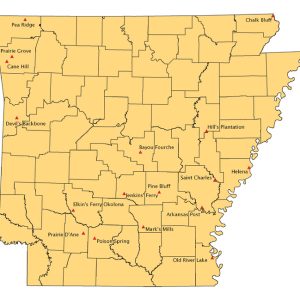calsfoundation@cals.org
Action at Pine Bluff
| Location: | Jefferson County |
| Campaign: | Little Rock Campaign (1863) |
| Date(s): | October 25, 1863 |
| Principal Commanders: | Colonel Powell Clayton (US); Brigadier Gen. John S. Marmaduke (CS) |
| Forces Engaged: | Pine Bluff Garrison (US); Newton’s Division, Greene’s Division, Monroe’s Brigade (CS) |
| Estimated Casualties: | 56 (US); 40 (CS) |
| Result: | Union victory |
The Action at Pine Bluff was fought on October 25, 1863, when Brigadier General John Sappington Marmaduke’s Confederate cavalry division attacked the small Union garrison under Colonel Powell Clayton that had occupied Pine Bluff (Jefferson County) following the capture of Little Rock (Pulaski County) on September 10, 1863. The purpose was to return the strategic initiative to the Confederacy.
Marmaduke led a force of some 2,000 Rebels out of Princeton (Dallas County) on October 24 to assault the 1,200 to 1,500 Union troopers of the Fifth Kansas Cavalry and the First Indiana Cavalry, which were posted at Pine Bluff with their six artillery pieces. Marmaduke planned for Colonel Robert C. Newton’s division to approach Pine Bluff from the southeast while Marmaduke led the remaining Confederate troops in from the west, trapping the Yankees between the converging Confederate forces and the Arkansas River.
A patrol from the Fifth Kansas encountered Marmaduke’s advance on the Princeton Road at about nine o’clock in the morning on October 25 and sent word to Clayton in Pine Bluff. The Union commander ordered most of the horses of his two regiments corralled within the courthouse square and sent for about 300 freed slaves within Pine Bluff’s contraband camp (contraband being freedmen or slaves who had been brought within Union lines) to roll cotton bales from the city’s warehouses and form breastworks to block the streets leading into the courthouse square.
Outlying Union forces, many of whom had been sniping from houses within Pine Bluff at the approaching Rebels, fell back toward the courthouse area before steady pressure from Marmaduke’s troopers. The makeshift cotton-bale fortifications proved a formidable obstacle, and the Confederate attack stalled before the Union rifle and artillery fire that commanded the roads leading into the courthouse square. Clayton made further use of the contraband camp, dispatching some 200 black men to haul enough water from the Arkansas River to enable the Yankee garrison to hold out for forty-eight hours if cut off from their water supply. Fifteen of the former slaves who had guns also engaged in combat against the Rebel attackers.
Shortly after noon, Marmaduke’s men set fire to the houses northwest of the square where the Fifth Kansas had been staying. The contrabands provided a bucket brigade to keep the fire from igniting Clayton’s cotton-bale defenses, and volunteers entered the burning buildings to save a large number of mules that were trapped inside. By mid-afternoon, after hours of hitting the Yankees with rifle and artillery fire, Marmaduke concluded that his only hope for victory would be a full frontal assault against the Federal barricades and that such an attack would be too costly in Confederate casualties. Seizing or burning as much of the equipment of the Yankee garrison as possible, the Rebels fell back toward Princeton.
Confederate losses totaled about forty dead and wounded in the unsuccessful attack on Pine Bluff, but the Rebels did capture some 300 contraband men, women, and children and seized 250 mules and horses, as well as destroying hundreds of bales of cotton that had been brought into Pine Bluff for sale to the Yankees. However, Marmaduke had failed in his goal of capturing the Federal garrison at Pine Bluff. He assessed the battle in his report by writing, “My troops behaved well. The Federals fought like devils.” Union losses were sixteen dead, thirty-nine wounded, and one missing; eighteen of those casualties were from among the contrabands who had aided the Federal defense. For the rest of the year, the Federals would maintain winter quarters along the line of the Arkansas River while Confederates held their positions in southwest Arkansas. The Action at Pine Bluff was the last sizeable military engagement in Arkansas in 1863.
For additional information:
Bearss, Edwin C. “Marmaduke Attacks Pine Bluff.” Arkansas Historical Quarterly 22 (Winter 1964): 291–313.
Christ, Mark K. Civil War Arkansas, 1863: The Battle for a State. Norman: University of Oklahoma Press, 2010.
———. “The Federals Fought Like Devils.” North & South 12 (March 2011): 40–48.
The War of the Rebellion: A Compilation of the Official Records of the Union and Confederate Armies. Series 1, Volume 22. Washington DC: Government Printing Office, 1890–1901, pp. 721–739.
Mark K. Christ
Arkansas Historic Preservation Program
 Civil War Events Map
Civil War Events Map  Powell Clayton
Powell Clayton  John Marmaduke
John Marmaduke 




Comments
No comments on this entry yet.